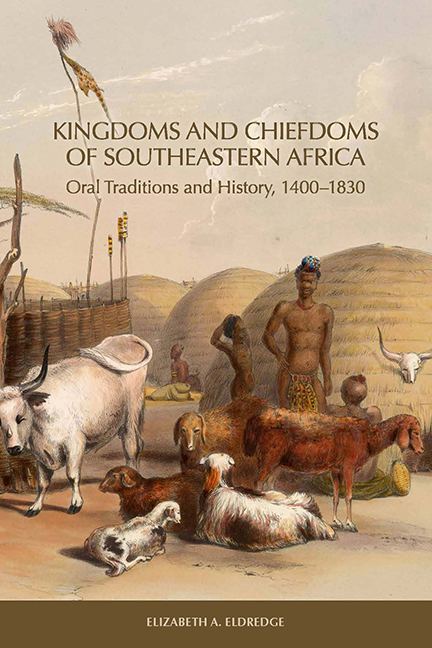Book contents
- Frontmatter
- Contents
- List of Illustrations
- Preface
- 1 History and Oral Traditions in Southeastern Africa
- 2 Oral Traditions in the Reconstruction of Southern African History
- 3 Shipwreck Survivor Accounts from the Sixteenth and Seventeenth Centuries
- 4 Founding Families and Chiefdoms East of the Drakensberg
- 5 Maputo Bay Peoples and Chiefdoms before 1740
- 6 Maputo Bay, 1740–1820
- 7 Eastern Chiefdoms of Southern Africa, 1740–1815
- 8 Zulu Conquests and the Consolidation of Power, 1815–21
- 9 Military Campaigns, Migrations, and Political Reconfiguration
- 10 Ancestors, Descent Lines, and Chiefdoms West of the Drakensberg before 1820
- 11 The Caledon River Valley and the BaSotho of Moshoeshoe, 1821–33
- 12 The Expansion of the European Presence at Maputo Bay, 1821–33
- 13 Southern African Kingdoms on the Eve of Colonization
- Appendix A Ama Swazi King Lists
- Appendix B Chronology of Conflicts, Migrations, and Political Reconfiguration East of the Drakensberg in the Era of Shaka
- Appendix C Interviewees from the James Stuart Collection of Oral Traditions
- Notes
- Bibliography
- Index
12 - The Expansion of the European Presence at Maputo Bay, 1821–33
Published online by Cambridge University Press: 14 March 2018
- Frontmatter
- Contents
- List of Illustrations
- Preface
- 1 History and Oral Traditions in Southeastern Africa
- 2 Oral Traditions in the Reconstruction of Southern African History
- 3 Shipwreck Survivor Accounts from the Sixteenth and Seventeenth Centuries
- 4 Founding Families and Chiefdoms East of the Drakensberg
- 5 Maputo Bay Peoples and Chiefdoms before 1740
- 6 Maputo Bay, 1740–1820
- 7 Eastern Chiefdoms of Southern Africa, 1740–1815
- 8 Zulu Conquests and the Consolidation of Power, 1815–21
- 9 Military Campaigns, Migrations, and Political Reconfiguration
- 10 Ancestors, Descent Lines, and Chiefdoms West of the Drakensberg before 1820
- 11 The Caledon River Valley and the BaSotho of Moshoeshoe, 1821–33
- 12 The Expansion of the European Presence at Maputo Bay, 1821–33
- 13 Southern African Kingdoms on the Eve of Colonization
- Appendix A Ama Swazi King Lists
- Appendix B Chronology of Conflicts, Migrations, and Political Reconfiguration East of the Drakensberg in the Era of Shaka
- Appendix C Interviewees from the James Stuart Collection of Oral Traditions
- Notes
- Bibliography
- Index
Summary
Rising demographic and political turmoil across southeastern Africa on both sides of the Drakensberg Mountains in the 1820s, occasioned by ambitious chiefs, drought, famine, and despair, coincided with a rising European interest in the region from both east and west. At Maputo Bay, site of the earliest European foothold in the area, the complacent and haphazard Portuguese presence was suddenly threatened by inland violence in 1821 and by the arrival of a British survey ship in 1822.
The first AmaZulu defeat of the AmaNdwandwe under Chief Zwide in 1821 had serious repercussions in the region of Maputo Bay. The Portuguese referred to the arrival of the migrant AmaNdwandwe chiefdoms from the south to the outskirts of Delagoa (Maputo) Bay as the “invasion of the Vatwahs.” The first report from a governor at Lourenço Marques, the Portuguese settlement at the bay, was made in a letter of Caetano da Costa Matozo, dated July 11, 1821. He wrote that on July 5, 1821, the Tembe territory of Chief Capella had been invaded by Chief “Inhaboza,” master of the lands south of Santa Lucia, who had come with a force of eight thousand men, more or less. He said it was true that “Capella,” that is, Muhadane, now an old man, was capable of countering this, but the enemy had caused such a panic that Muhadane's (Capella's) people had fLed and only the young chief Mayeta had opposed the enemy with a column of warriors. These fought with such valor that the invaders were routed, but not before there had been many casualties, making them unwilling to prosecute the war further because they did not believe they could defeat the invaders. The Tembe chief Mayeta had informed the governor that he could not raise sufficient forces because his people had lost their spirit of resistance, and he was obliged to retreat. Chief “Capella” himself took refuge on a small island with his relatives, and the enemy ranged freely over his territory, stealing the cattle and leaving the villages in fLames.
- Type
- Chapter
- Information
- Kingdoms and Chiefdoms of Southeastern AfricaOral Traditions and History, 1400–1830, pp. 294 - 312Publisher: Boydell & BrewerPrint publication year: 2015

